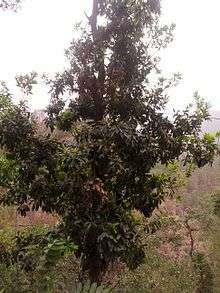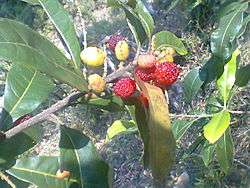Myrica esculenta
| Myrica esculenta | |
|---|---|
 | |
| Scientific classification | |
| Kingdom: | Plantae |
| (unranked): | Angiosperms |
| (unranked): | Eudicots |
| (unranked): | Rosids |
| Order: | Fagales |
| Family: | Myricaceae |
| Genus: | Myrica |
| Species: | M. esculenta |
| Binomial name | |
| Myrica esculenta | |
| Synonyms | |
|
Box myrtle | |
Myrica esculenta is a small tree or large shrub native to the hills of northern India and Nepal. Its common names include Box myrtle, Bayberry, Kaphal (local name in India and Nepal).
Habitat
It is found in hilly regions of northern India and Nepal especially in the regions of Garhwal and Kumaon of Uttarakhand and western Nepal especially at elevations between 3,000 and 6,000 feet.[2] It is also found at elevations below 1500 m in the midhills of Nepal.
Morphology
It has a tree of medium height i.e. 20 to 25 feet. Bark is soft and brittle. Leaves are conjoint, 1 to 2 feet long that has leaflets in pairs of 6 to 9 and has a width of ¼ inch. Flowers are of white color and are found in bunches. Fruit is a globose, succulent drupe, with a bard endocarp; diameter 1.1 to 1.3 cm; average mass 670 mg. Seeds are triangular in shape and are astringent in taste.
According to Ayurveda, it has two varieties based on the color of flower: Shwet (white) and Rakta (red).[2]
Chemical constituents
The bark is yellow and contains the chemical substances myricetin, myricitrin and glycosides.[2] Leaves of the plant also contain flavone-4'-hydroxy-3',5,5'-trimethoxy-7-O-β-I-D-glucopyranosy)(1→4)-α-L-rhamnopyranoside; flavone-3',4'-dihydroxy-6-methoxy-7-O-α-L-rhamnopyranoside; β-sitosterol; β-sitosterol-β-D-glucopyranoside and quercetin.[3]
Toxicology
It has no toxic effect when consumed in normal dosage.[2]
References
- ↑ "medicinal herbs". ayushveda.com. Retrieved 2011-01-26.
- 1 2 3 4 "Myrica esculenta". ayushveda.com. Retrieved 2011-01-26.
- ↑ Bamola A, Semwal DK, Semwal S, Rawat U. Flavonoid glycosides from Myrica esculenta leaves. Journal of the Indian Chemical Society. 2009;86(5):535-6.
